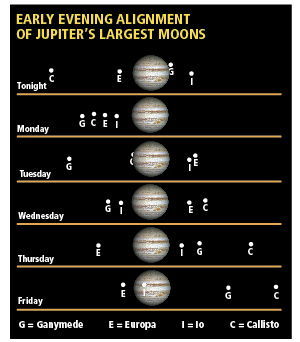I know you’ve seen it: that super-bright star beaming in the southeast sky as soon as darkness sets in. Except that’s no star; it’s Jupiter, the big guy of our solar system.
Jupiter is basically a big ball of hydrogen and helium gas with a diameter of around 88,000 miles, more than 11 times that of our Earth. Through a telescope, even a small one, it’s possible to see at least some of its darker cloud bands made up of methane, ammonia, and sulfur compounds. You can especially pick up on at least two darker cloud bands on either side of Jupiter’s equator. There’s actually some subtle color to them.
With larger scopes you’ll see more bands and more detail, and maybe even the Great Red Spot, a giant storm raging on Jupiter. It’s called the red spot, but in reality it will show up in a larger scope with a pale pink hue. The red spot isn’t always available, though, because of Jupiter’s speedy 10-hour rotation. Half of the time the red spot is turned away from Earth. As I’ve told you before, the longer you gaze at Jupiter through the eyepiece of your scope, the more detail you’ll see. Try to look at it for at least 10-minute shots.
No matter how big or small your telescope is, you’ll get a kick out of watching Jupiter’s four brightest moons, Io, Europa, Callisto, and Ganymede, as they orbit around their gravitational master in periods of less than two days to just over 16 days. Because of their continual dance, they will constantly be changing positions relative to the disk of Jupiter. Some nights you may see two on one side and two on the other, or three on one side and one on the other, or all four on one side. There are also many nights when you can’t see all four at one time because one or more moons may be behind of or in front of Jupiter from our Earthly vantage. When a moon is behind Jupiter you obviously have no shot at seeing it, but when one is in front of the disk of the planet you may see the dot of its shadow on Jupiter, although you need a moderate to larger telescope to see this. With Jupiter’s relative proximity this month and most of this upcoming fall, you have a chance of seeing a moon shadow on Jupiter even with some of the smaller scopes. It’s worth a try.
In the diagram I show the positions of Jupiter’s moons during the coming week. This coming Saturday night, if your scope is up to it, you may see the shadow of Io on the face of Jupiter, and this coming Sunday Europa’s shadow will dot the planet’s disk. Consider this extra credit if you see these two shadowy events next weekend.
Jupiter actually has more than 60 known moons and probably many more that haven’t been confirmed yet, but the four larger moons that we see through our backyard telescopes are certainly the best known. They’re also referred to as the Galilean moons, because the great astronomer and scientist Galileo used these moons to help prove that the sun, and not the Earth, was the center of what was then seen as the universe.
Io is the closest moon at a little over 2,200 miles in diameter. A little larger than our moon, it’s the most geologically active body in our solar system. Since it’s only about a quarter of a million miles from the very massive Jupiter, there’s a colossal gravitational wallop on Io from the mother ship. The tidal forces are tremendous, and because of the constant stretching heat builds up in Io’s interior to the point of melting. This in turn produces numerous and frequent volcanic eruptions.
The next moon out from Jupiter, Europa, may be the best candidate for life in our solar system. Europa is covered by a sheet of ice, and there may be an ocean of liquid water beneath it, or at least a slushy ocean. Once again, because it’s so close to Jupiter the tidal forces are strong enough to heat up Europa’s interior, possibly allowing for liquid water below the ice. Where there is liquid water there’s a chance of life as we know it. Stay tuned.
Callisto and Ganymede are the largest and farthest away from Jupiter of the Galilean moons, and are both larger than our moon. In fact, Ganymede is even a little larger than Mercury, the closest planet to the sun. Both Ganymede and Callisto are heavily cratered bodies and are comparatively nowhere near as interesting as Io and Europa.
Enjoy the never-ending dance of Jupiter’s moons.
Mike Lynch is an amateur astronomer and professional broadcast meteorologist for WCCO Radio in Minneapolis and is author of the book, “Stars, a Month by Month Tour of the Constellations” published by Adventure Publications available at bookstores at http://www.adventurepublications.net
Talk to us
> Give us your news tips.
> Send us a letter to the editor.
> More Herald contact information.

























